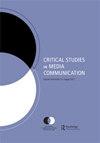四方方言话语:脆弱、指导和在YouTube上出柜
IF 1.5
2区 文学
Q3 COMMUNICATION
引用次数: 1
摘要
本文认为,黑人酷儿青年在YouTube上分享的出柜叙事可以被理解为一种方正的白话话语,它捕捉了他们的修辞动作,照亮了他们的物质现实,并参与了黑人酷儿世界的构建。认识到黑人酷儿青年如何使用社交媒体仍有许多未知之处,我扩展了四方方言话语来研究种族和性的物质交叉点,并扩展了四方理论,以包括这些原本隐藏的修辞。首先,我从YouTube上的27个即将出柜的故事中得出结论,认为叙述者用他们的故事来阐明他们如何驾驭方形物质脆弱性。其次,我认为叙述者的方言话语阐明了黑人酷儿男孩和年轻人是如何被激励去分享他们的故事的,这有助于维持一个方言社区。叙述者像导师一样,扩大了各种可能性,增加了在线公共知识库,用他们的故事来指导那些可能缺乏榜样或没有支持结构的弱势黑人酷儿青年。本文章由计算机程序翻译,如有差异,请以英文原文为准。
Quare vernacular discourse: vulnerability, mentorship, and coming out on YouTube
ABSTRACT This essay argues that coming out narratives shared by Black queer youth on YouTube can be understood as a quare vernacular discourse that captures their rhetorical moves, illuminates their material realities, and participates in Black queer worldmaking. Recognizing that much remains uncharted about how Black queer youth use social media, I extend quare vernacular discourse to examine the material intersections of race and sexuality, and expand quare theory to include these otherwise hidden rhetorics. First, I work from 27 coming out narratives on YouTube to argue that narrators use their stories to articulate how they navigate quare material vulnerability. Second, I contend that narrators’ quare vernacular discourse illuminates how Black queer boys and young men are motivated to share their stories, helping to sustain a quare vernacular community. Expanding quare possibilities and adding to an online communal knowledge pool, narrators, much like mentors, use their stories to guide vulnerable Black queer youth who may have few role models or no support structures.
求助全文
通过发布文献求助,成功后即可免费获取论文全文。
去求助
来源期刊

Critical Studies in Media Communication
COMMUNICATION-
CiteScore
2.10
自引率
0.00%
发文量
34
期刊介绍:
Critical Studies in Media Communication (CSMC) is a peer-reviewed publication of the National Communication Association. CSMC publishes original scholarship in mediated and mass communication from a cultural studies and/or critical perspective. It particularly welcomes submissions that enrich debates among various critical traditions, methodological and analytical approaches, and theoretical standpoints. CSMC takes an inclusive view of media and welcomes scholarship on topics such as • media audiences • representations • institutions • digital technologies • social media • gaming • professional practices and ethics • production studies • media history • political economy. CSMC publishes scholarship about media audiences, representations, institutions, technologies, and professional practices. It includes work in history, political economy, critical philosophy, race and feminist theorizing, rhetorical and media criticism, and literary theory. It takes an inclusive view of media, including newspapers, magazines and other forms of print, cable, radio, television, film, and new media technologies such as the Internet.
 求助内容:
求助内容: 应助结果提醒方式:
应助结果提醒方式:


